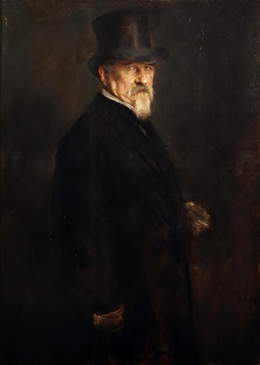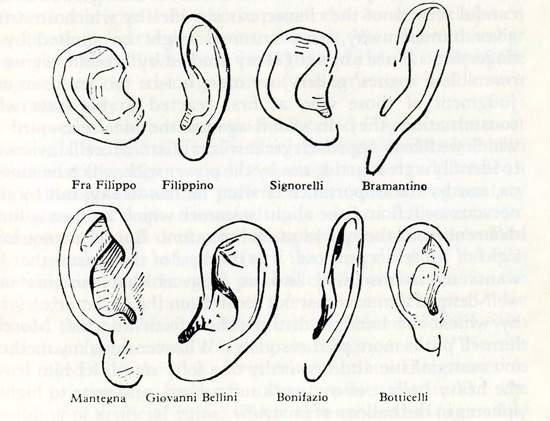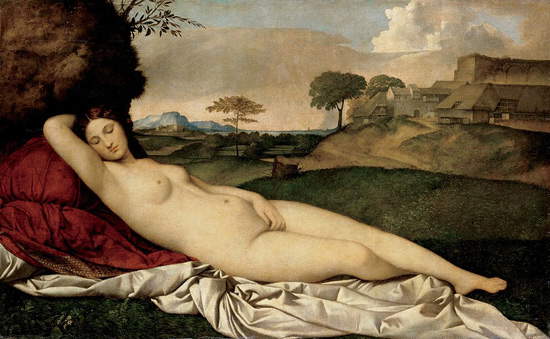When newspapers present us with a new artistic discovery, we always witness the stances of various scholars, who either take sides in favor of an attribution to a particular artist, or take completely contrary views, tracing the work back to other hands. One question that often characterizes the curiosity of those who attend the debates is: how does one attribute a painting? Answering this question means traversing centuries of the history of connoisseurship, an Anglo-French term for that in-depth ability on the part of expert art connoisseurs to express opinions about works. We have therefore decided to go over, briefly and without pretending to provide in-depth pictures, the main stages of this history, starting with the figure of Giovanni Morelli (1816 - 1891) and his method based on the identification of so-called sigla motifs.
 |
| Franz von Lenbach, Portrait of Giovanni Morelli (1886; Bergamo, Accademia Carrara) |
It was in Milan that Morelli met art historians and collectors for whom he also began to work (for example, he was a consultant to Marquis Giuseppe Arconati Visconti), providing opinions in negotiations for the purchase of works of art. Significant was the journey he undertook with another great scholar, Giovanni Battista Cavalcaselle (1819 - 1897), between Marche and Umbria to compile a catalog of the works of art preserved in those regions-a study commissioned by Cavour immediately after the Unification of Italy in 1861.
During his years of activity, Morelli developed a particular method, destined to influence many art historians who came after him. The scholar, imbued as he was with positivism, had sought to devise a method that could apply the rigor of science to the art historian’s investigation: Morelli therefore published a series of writings, under the Russian pseudonym of Ivan Lermolieff (the surname is nothing more than an anagram of “Morelli” with the addition of the ending typical of Russian surnames), in the Viennese journal Zeitschrift für bildende Kunst (“Journal of Art History”), in which he enunciated the principles of his method, which were then further developed in a single work, published in 1890 and entitled Kunstkritische Studien über Italienische Malerei (“Art Critical Studies on Italian Painting”), translated into Italian by Gustavo Frizzoni in 1897. The most curious aspect of the latter work consists in the fact that it is written in the form of a dialogue: a choice in line with the propensity for dialogue typical of Romantic writers, whom Morelli frequented in Berlin, as well as suitable for circulating his ideas to a wider audience, which could be better attracted by a lighter literary form than that of the treatise.
Morelli, in essence, believed that an artist’s hand could be identified through characteristic and recurring anatomical details in his art, which the painter repeated in an almost mechanical way, since he himself considered them insignificant in the context of the whole composition. These would be the sigla motifs (or the “Morellian figures,” as they were later called) that would allow the scholar to correctly assign an attribution. But what are these secondary details? For example, the shape of the earlobe, the contour of the eyelids, the length of the phalanges, the conformation of the fingers. Morelli also explains why the scholar should focus on these details: the more obvious ones (for example, the expression of a face or a way of smiling, such as Leonardo’s) would in fact be able to extend to other artists (think of artists in a workshop or school imitating their master), while the more insignificant details would not run this risk. So, venturing a comparison, we could say that just as the biologist makes comparisons between the anatomical details of animals in order to classify them, so the art historian compares the anatomical details of characters in works in order to formulate attributions.
 |
| Ears and hands of different artists (illustration taken from the English edition of Kunstkritische Studien über Italienische Malerei) |
Alongside the sigla motifs, which constitute the main class of characters that should lead, according to Morelli, to the identification of a painter’s hand, there would exist two other classes of peculiar traits, for a total of three categories, which would help the scholar to formulate the most correct attribution of the painting. One of the two remaining classes is composed of the poses and attitudes, as well as the shapes of the face and the course of the drapery: these are the characteristics that connote the composition in general, and are considered the least important by Morelli, precisely because they are more evident and therefore more subject to the risk of influencing or being influenced. Finally, the last class is that of the so-called habitual manners, to use the expression used by Morelli himself: recurring details in the works of a painter, which the painter himself inserts without realizing it. These “habitual manners” are nothing more than the result of the repetition of sigla motifs and would therefore reveal the identity of an artist. A great art historian, Enrico Castelnuovo, has effectively compared the Morellian method to that of Sherlock Holmes: like the scholar, Arthur Conan Doyle ’s character was able to discover the perpetrator of a crime through the analysis of minute and seemingly insignificant details, but which unmistakably betrayed the culprit. After all, Sherlock Holmes is the first literary character to represent the detective applying the nineteenth-century scientific method in his investigations (and Arthur Conan Doyle was a contemporary of John Morelli).
 |
| Ears of different artists (illustration taken from the English edition of Kunstkritische Studien über Italienische Malerei) |
Using this method, Morelli arrived at surprising results: in fact, he formulated several attributions that even today appear to us to be exceedingly robust and have marked the history (and one might even say the fortunes) of certain artists. Just think of the attention that Giovanni Morelli devoted to Giorgione: to the Venetian artist, Morelli assigned some paintings such as the Judith in the Hermitage in St. Petersburg, the Young Man with Flute in Hampton Court, the so-called Giustiniani Portrait in Berlin, and above all the Venus of Dresden, which certainly remains his most famous and successful attribution, as it is still widely accepted by almost all critics today (although there is a tendency to identify in the painting also the hand of Titian, who would have completed it). Until Morelli’s attribution, formulated in 1880 in his work Le opere dei maestri italiani nelle gallerie di Monaco, Dresda e Berlino (title translated from the original German), the work was believed to be a copy from Titian executed by Sassoferrato: the scholar, analyzing certain details (such as the oval of the face, the shape of the thumb, the folds of the sheet) not only assigned the work to Giorgione, but also marveled that before him no one had noticed the masterpiece hanging in the halls of the Gemäldegalerie in Dresden.
However, the Morellian method attracted several criticisms, beginning with those of his colleague Cavalcaselle, who favored instead an approach based mainly on the overall impression, and particularly scornful was also the definition that Adolfo Venturi (1856 - 1941) reported about Morelli’s work, referring to his method with the expression"orecchiuta criticism": the adjective was intended to denigrate the typically Morellian predilection for the most minute anatomical attributes (such as the ears, precisely). It should also not be forgotten that the method had heavy limitations, acknowledged even by Morelli himself, who considered it applicable only to Renaissance works: from Mannerism onward, imitation of the greats of the Renaissance would in fact make attributions without significant margins of error much more difficult. Morelli’s method, however, also had several admirers, the most important of whom was probably Bernard Berenson (1865 - 1959): today, although the approach that emphasizes above all the less obvious details is considered somewhat outdated, since the considerable importance of an overall view of the composition in order to formulate a correct attribution is now well established, it is certainly possible to assert that Morelli’s method has constituted a fundamental basis that has helped the work of many art historians.
 |
| Giorgione, Venus (c. 1507-1510; Dresden, Gemäldegalerie) |
Warning: the translation into English of the original Italian article was created using automatic tools. We undertake to review all articles, but we do not guarantee the total absence of inaccuracies in the translation due to the program. You can find the original by clicking on the ITA button. If you find any mistake,please contact us.